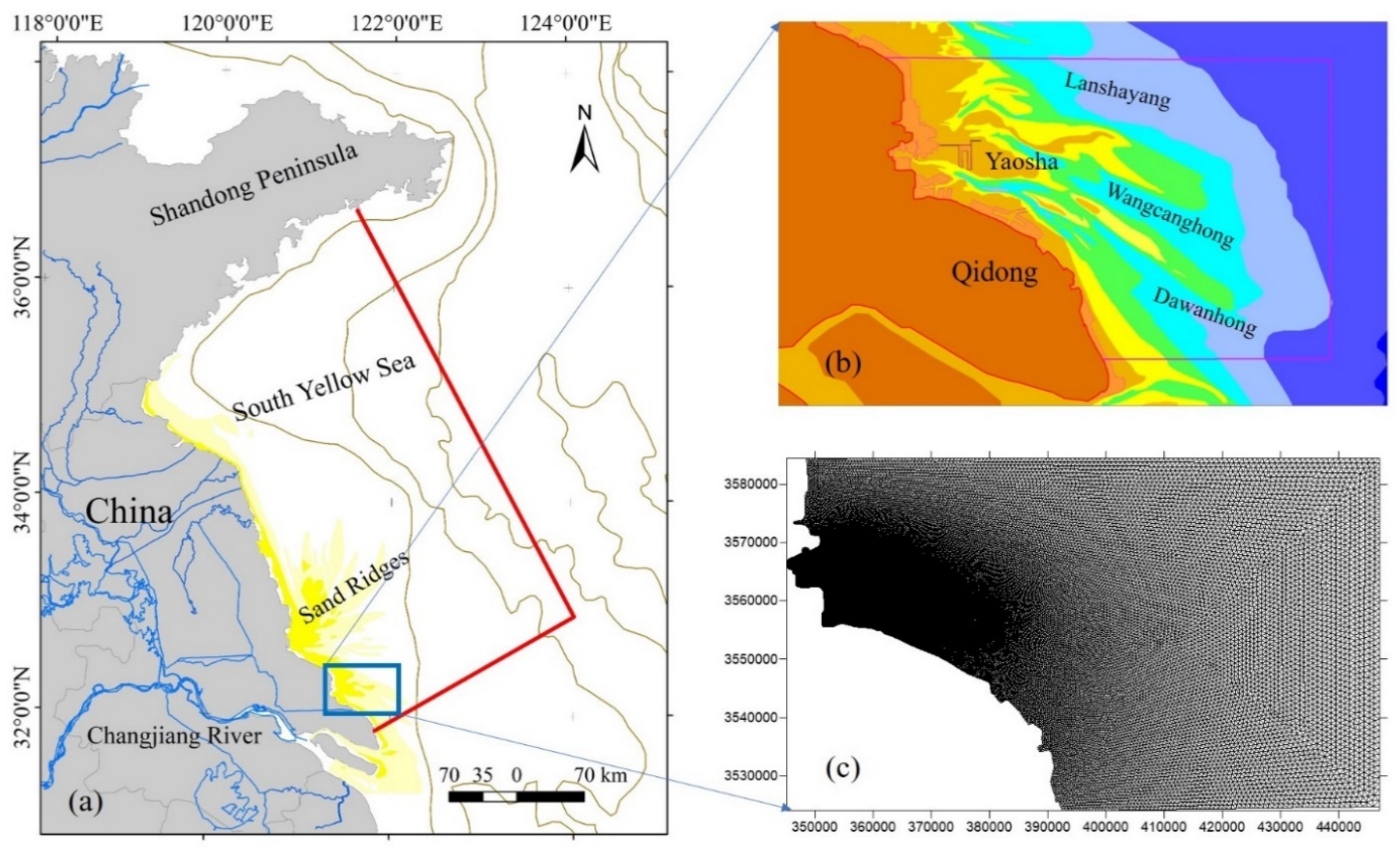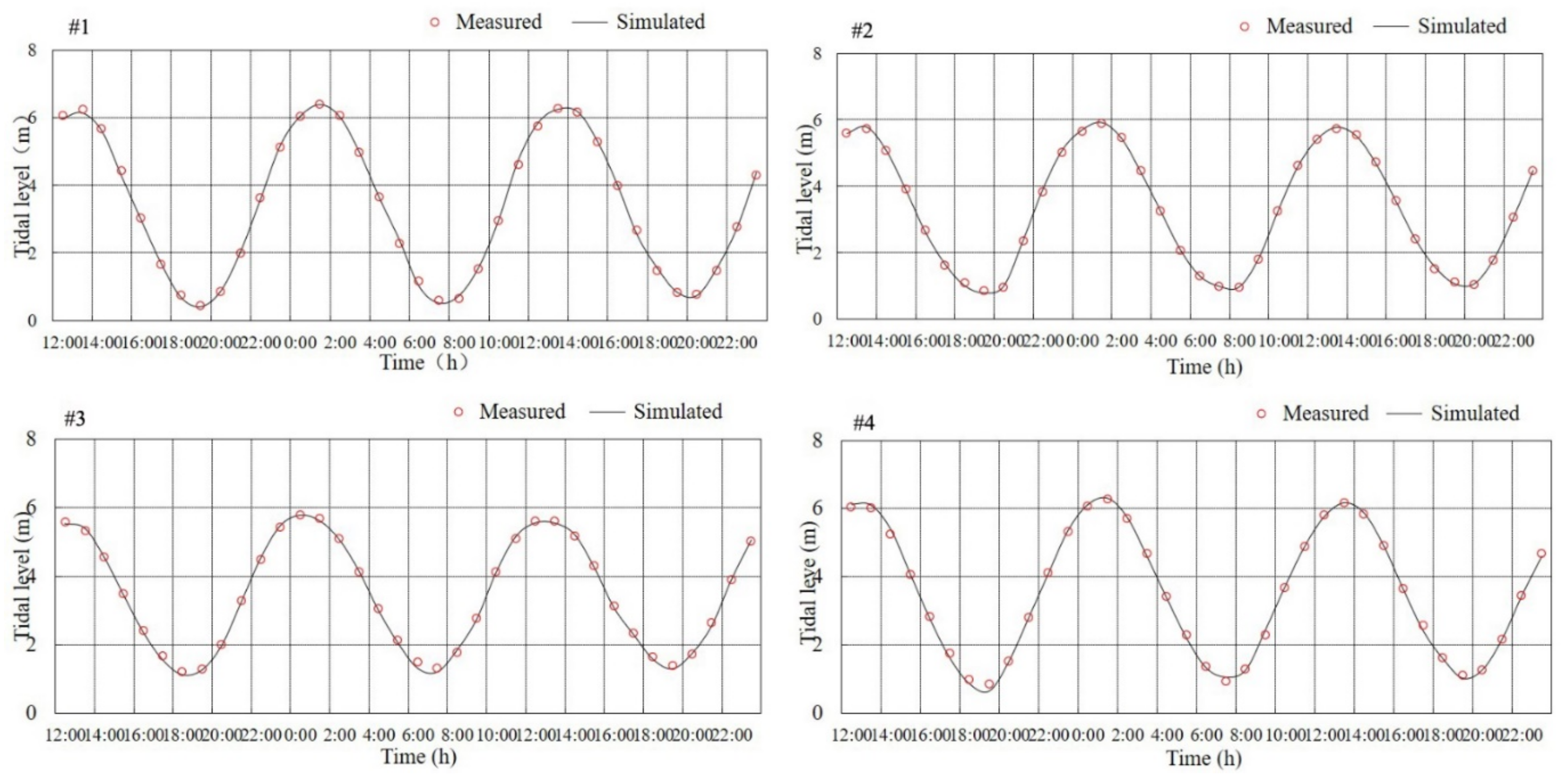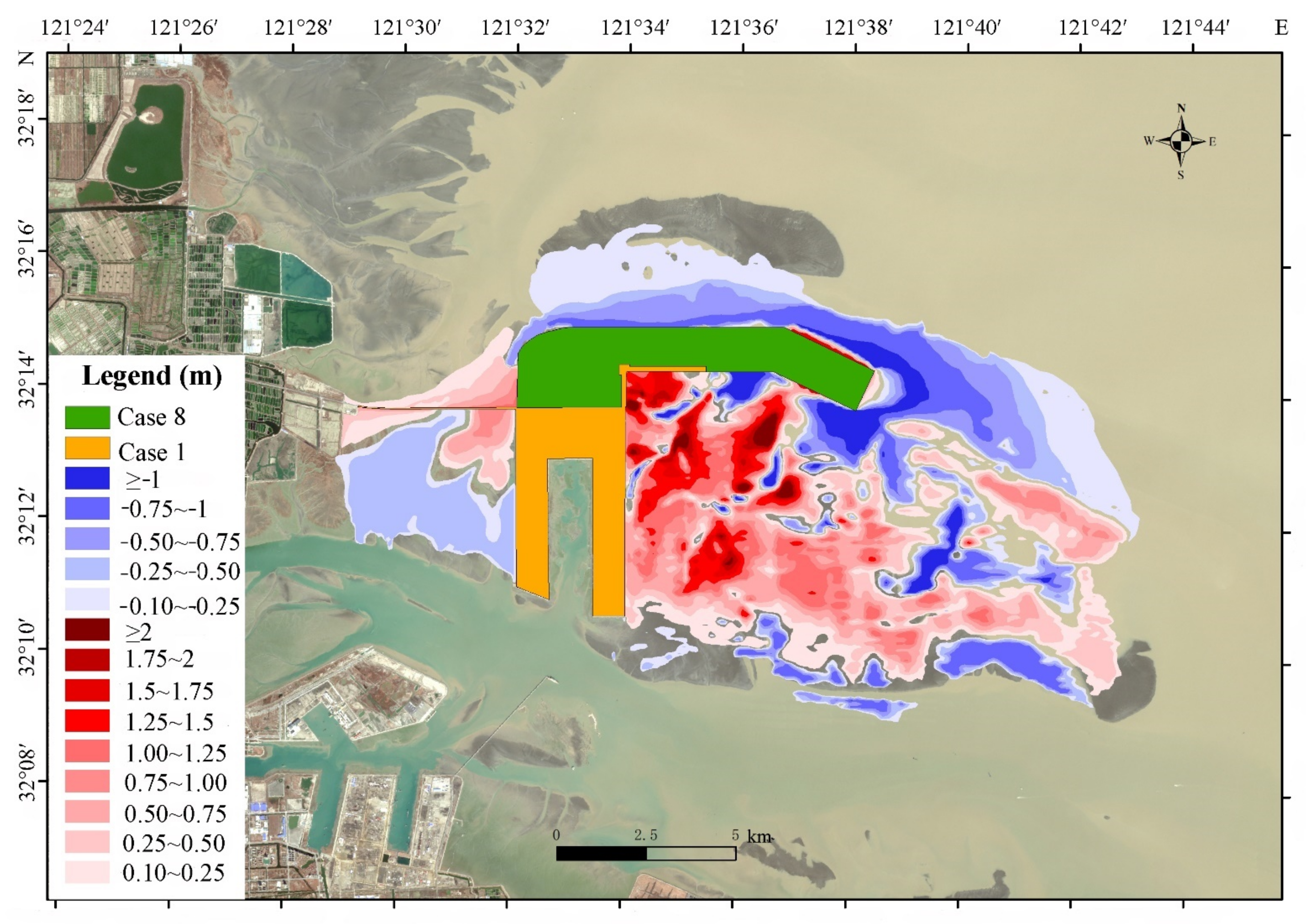Research on the Limit Values of Reclamation Based on Ecological Security: A Case Study of Tongzhou Bay in Rudong, Jiangsu Province
Abstract
:1. Introduction
2. Materials and Methods
2.1. Study Area
2.2. Data
2.3. Methods
2.3.1. Numerical Model
2.3.2. Model Validation
3. Results and Discussion
3.1. Selection of the Ecological Evaluation Indices and Limit Values of Reclamation in Tongzhou Bay
3.2. Reclamation Project Case and its Environmental Impact
Impacts of Reclamation on the Change in Water Area and Water Time in Yaosha
3.3. Determination of Reclamation Limit Value Scheme
3.4. Check Limit Value of Reclamation Based on the Stable State of the Topographic Deposition-Erosion Balance
4. Conclusions
- (1)
- The stability of sandbanks is the decisive factor for maintaining the ecological function of the Yaosha wetland in Tongzhou Bay. According to the factors affecting the stability of sandbanks, the change rate of tidal flux ±5%, the relatively stable position of the diversion line and confluence line, and the water area and water time above the 0 m line in Yaosha are used to determine the limit values of reclamation.
- (2)
- Eight reclamation schemes for Yaosha in Tongzhou Bay are selected, which mainly include the undeveloped natural state, development status, and possible construction scale according to the time sequence of port engineering construction. After the implementation of the reclamation projects, the engineering area prevents water influx and deflects flow during flood and ebb tides. The construction of the dike cuts off part of a tidal creek, which affects the flow path of the local channel flow. The ebb and flow dividing line shows little change in different schemes for Yaosha. The tidal flux of each scheme has a different degree of change, and the variation range of tidal flux at the end of the channel is greater than that at the open sea. Except for case 5 and case 7, the other schemes result in small proportional decreases in the water area of Yaosha, whereas the water time of Yaosha has little influence in this study.
Supplementary Materials
Author Contributions
Funding
Institutional Review Board Statement
Informed Consent Statement
Data Availability Statement
Conflicts of Interest
References
- Wang, Y. Marine Geography of China; Science Press: Beijing, China, 1996. [Google Scholar]
- Kennedy, V.S.; Twilley, R.R.; Kleypas, J.A.; Cowan, J.H., Jr.; Hare, S.R. Coastal and Marine Ecosystems & Global Climate Change: Potential Effects on US Resources; Pew Center on Global Climate Change: Arlington, VA, USA, 2002. [Google Scholar]
- Alizad, K.; Hagen, S.C.; Morris, J.T.; Medeiros, S.C.; Bilskie, M.V.; Medeiros, S.C. Coastal wetland response to sea-level rise in a fluvial estuarine system. Earths Future 2016, 4, 483–497. [Google Scholar] [CrossRef]
- Deng, Y.; Horrocks, M.; Ogden, J.; Anderson, S. Modern pollen–vegetation relationships along transects on the Whangapoua Estuary, Great Barrier Island, northern New Zealand. J. Biogeogr. 2006, 33, 592–608. [Google Scholar] [CrossRef]
- Rodríguez, J.F.; Howe, A. Estuarine wetland ecohydraulics and migratory shorebird habitat restoration. Ecohydraul. Integr. Approach 2013, 375–394. [Google Scholar] [CrossRef]
- Krauss, K.W.; Noe, G.B.; Duberstein, J.A.; Conner, W.H.; Stagg, C.L.; Cormier, N.; Jones, M.C.; Bernhardt, C.E.; Graeme Lockaby, B.; From, A.S.; et al. The role of the upper tidal estuary in wetland blue carbon storage and flux. Glob. Biogeochem. Cycles 2018, 32, 817–839. [Google Scholar] [CrossRef]
- Reddy, S.M.; Guannel, G.; Griffin, R.; Faries, J.; Boucher, T.; Thompson, M.; Brenner, J.; Bernhardt, J.; Verutes, G.; Wood, S.A.; et al. Evaluating the role of coastal habitats and sea-level rise in hurricane risk mitigation: An ecological economic assessment method and application to a business decision. Integr. Environ. Asses. 2016, 12, 328–344. [Google Scholar] [CrossRef] [PubMed]
- Intergovernmental Oceanographic Commission of UNESCO (IOCO); International Maritime Organisation (IMO); Food and Agriculture Organization (FAO); United Nations Development Programme (UNDP). A Blueprint for Ocean and Coastal Sustainability an Inter-Agency Paper towards the Preparation of the UN Conference on Sustainable Development; IOC/UNESCO: Paris, France, 2011. [Google Scholar]
- Xu, N.; Wang, Y.Q.; Huang, C.H.; Jiang, S.; Jia, M.M.; Ma, Y. Monitoring coastal reclamation changes across Jiangsu Province during 1984–2019 using landsat data. Mar. Policy 2022, 136, 104887. [Google Scholar] [CrossRef]
- Syvitski, J.P.M.; Harvey, N.; Wolanski, E.; Burnett, W.C.; Perillo, G.M.E.; Gornitz, V.; Arthurton, C.R.K.; Bokuniewicz, H.; Campbell, J.W.; Cooper, L.; et al. Dynamics of the Coastal Zone. In Coastal Fluxes in the Anthropocene; Global Change—The IGBP Series; Springer: Berlin/Heidelberg, Germany, 2005; pp. 39–94. [Google Scholar]
- Maselli, V.; Trincardi, F. Man made deltas. Sci. Rep. 2013, 3, 1926. [Google Scholar] [CrossRef] [PubMed] [Green Version]
- Woodruff, J.D.; Irish, J.L.; Camargo, S.J. Coastal flooding by tropical cyclones and sea-level rise. Nature 2013, 504, 44–52. [Google Scholar] [CrossRef] [PubMed] [Green Version]
- Yang, Y.; Chui, T.F.M. Hydrodynamic and transport responses to land reclamation in different areas of semi-enclosed subtropical bay. Cont. Shelf Res. 2017, 143, 54–66. [Google Scholar] [CrossRef]
- Qiu, L.F.; Zhang, M.; Zhou, B.B.; Cui, Y.Z.; Yu, Z.L.; Liu, T.; Wu, S.H. Economic and ecological trade-offs of coastal reclamation in the Hangzhou Bay, China. Ecol. Indic. 2021, 125, 107477. [Google Scholar] [CrossRef]
- Deegan, L.A.; Johnson, D.S.; Warren, R.S.; Peterson, B.J.; Fleeger, J.W.; Fagherazzi, S.; Wollheim, W.M. Coastal eutrophication as a driver of salt marsh loss. Nature 2012, 490, 388–392. [Google Scholar] [CrossRef] [PubMed]
- Yang, H.; Ma, M.G.; Thompson, J.R.; Flower, R.J. Protect coastal wetlands in China to save endangered migratory birds. Proc. Natl. Acad. Sci. USA 2017, 114, E5491–E5492. [Google Scholar] [CrossRef] [PubMed] [Green Version]
- Muller, J.R.; Chen, Y.P.; Aarninkhof, S.G.; Chan, Y.C.; Piersma, T.; van Maren, D.S.; Tao, J.F.; Wang, Z.B.; Gong, Z. Ecological impact of land reclamation on Jiangsu coast (China): A novel ecotope assessment for Tongzhou Bay. Water Sci. Eng. 2020, 13, 57–64. [Google Scholar] [CrossRef]







| Number | Indicator | Concepts and Types | Calculation Method | Limit Value |
|---|---|---|---|---|
| 1 | Catchment line and dividing line | The boundary line between the flood tide confluence and ebb tide divergence of sandbanks. | The identification of tidal current field at the end of high tide and the beginning of low tide is calculated via numerical simulation of the tidal current. | The catchment line and dividing line should be relatively stable compared with the current status. |
| 2 | Change in tide flux | The rate of change in the tidal flux at the time of maximum flood and maximum ebb along typical sections of the water channel. | Identification of tidal flux variability at 10 m depth sections in deep water channels before and after the project. | Control section at Sanshahong channel entrance: 5%; deep water channel tail reference section: ≤10% |
| 3 | Water area | The largest area submerged by ebb and flood tide water above 0 m on sandbars. | Identification of tidal level and water depth above the 0 m line of Yaosha. | - |
| 4 | Water time | The inundation time of tidal water in the area of sand ridge lines on sandbanks. | The tidal level and topographic recognition of ridge lines in Yaosha. | - |
| Number | Project Case | Description of The Project Case |
|---|---|---|
| 1 | Case 1 | Current situation of reclamation in Tongzhou Bay operation area |
| 2 | Case 2 | Reclamation of approximately 790 hectares in the NE part of the current project area |
| 3 | Case 3 | Reclamation of approximately 690 hectares in the NE part of the current project area |
| 4 | Case 4 | Reclamation of approximately 585 hectares in the NE part of the current project area |
| 5 | Case 5 | Reclamation of approximately 2470 hectares in the N part of the current project area |
| 6 | Case 6 | Reclamation of approximately 1135 hectares in the N part of the current project area |
| 7 | Case 7 | Case 4 + 5, reclamation of approximately 2790 hectares |
| 8 | Case 8 | Case 4 + 6, reclamation of approximately 1455 hectares |
| Project Case | Overlap Area with Yaosha 0 m Line (ha) | Water Area (ha) | Change Rate | Water Time in a Tidal Cycle |
|---|---|---|---|---|
| Case 1 | 1217.32 | 13,892.09 | / | 5 h 40 min |
| Case 2 | 1299.79 | 13,809.61 | −0.59% | 5 h 35 min |
| Case 3 | 1299.79 | 13,809.62 | −0.59% | 5 h 40 min |
| Case 4 | 1299.93 | 13,809.48 | −0.59% | 5 h 40 min |
| Case 5 | 2435.13 | 12,674.28 | −8.77% | 5 h 25 min |
| Case 6 | 1677.49 | 13,431.92 | −3.31% | 5 h 40 min |
| Case 7 | 2485.91 | 12,623.5 | −9.13% | 5 h 25 min |
| Case 8 | 1710.99 | 13,398.42 | −3.55% | 5 h 40 min |
| Project Case | Yaosha Stability | Water Channel Stability | Change Rate of Water Area | Water Line | ||||||||||
|---|---|---|---|---|---|---|---|---|---|---|---|---|---|---|
| Catchment Line | Dividing Line | DM1 | DM2 | |||||||||||
| Control the Maximum Variation Range of Section Flow | 2# Control Point Maximum Flow Velocity Change | 2# Control Point Maximum Flow Direction Change | Control the Maximum Variation Range of Section Flow | 4# Control Point Maximum Flow Velocity Change | 4# Control Point Maximum Flow Direction Change | |||||||||
| Maximum Flood | Maximum Ebb | Maximum Flood | Maximum Ebb | Maximum Flood | Maximum Ebb | Maximum Flood | Maximum Ebb | |||||||
| Case 2 | The catchment line in the middle of Yaosha moved northward, and the distribution pattern of the tail catchment line was basically consistent with the natural state | No change | −11.58% | 1.40% | −7.68% | 1.35% | 1.62% | −0.38% | −0.38% | −3.23% | −0.05% | −0.26% | −0.59% | 5 h 35 min |
| Case 3 | The catchment line in the middle of Yaosha moved northward, and the distribution pattern of the tail catchment line was basically consistent with the natural state | No change | −8.26% | −0.95% | −6.58% | 1.11% | 0.79% | −0.50% | −0.50% | −2.63% | −0.02% | −0.12% | −0.59% | 5 h 40 min |
| Case 4 | No change | −6.13% | −1.59% | −2.03% | 0.91% | 0.43% | −2.05% | −0.97% | −1.98% | 0.02% | −0.05% | - | −0.59% | 5 h 40 min |
| Case 5 | No change | −7.37% | −4.17% | −6.06% | 0.68% | 1.42% | −2.52% | −2.49% | −2.45% | 0.09% | 0.02% | - | −8.77% | 5 h 25 min |
| Case 6 | No change | −6.36% | −3.06% | −5.85% | 0.57% | 1.07% | −2.05% | −1.91% | −2.09% | 0.07% | 0.02% | - | −3.31% | 5 h 40 min |
| Case 7 | No change | −11.20% | −3.09% | −7.58% | 1.09% | 0.81% | −3.09% | −1.64% | −3.23% | 0.04% | −0.05% | - | −9.13% | 5 h 25 min |
| Case 8 | No change | −9.36% | −3.03% | −7.46% | 1.09% | 0.81% | −3.06% | −1.64% | −3.20% | 0.04% | −0.05% | - | −3.55% | 5 h 40 min |
Publisher’s Note: MDPI stays neutral with regard to jurisdictional claims in published maps and institutional affiliations. |
© 2022 by the authors. Licensee MDPI, Basel, Switzerland. This article is an open access article distributed under the terms and conditions of the Creative Commons Attribution (CC BY) license (https://creativecommons.org/licenses/by/4.0/).
Share and Cite
Zhang, H.; Zhao, L.; Du, W.; Liu, Q.; Zhao, Y.; Xu, M. Research on the Limit Values of Reclamation Based on Ecological Security: A Case Study of Tongzhou Bay in Rudong, Jiangsu Province. Int. J. Environ. Res. Public Health 2022, 19, 8301. https://doi.org/10.3390/ijerph19148301
Zhang H, Zhao L, Du W, Liu Q, Zhao Y, Xu M. Research on the Limit Values of Reclamation Based on Ecological Security: A Case Study of Tongzhou Bay in Rudong, Jiangsu Province. International Journal of Environmental Research and Public Health. 2022; 19(14):8301. https://doi.org/10.3390/ijerph19148301
Chicago/Turabian StyleZhang, Haifeng, Lin Zhao, Wen Du, Qing Liu, Yifei Zhao, and Min Xu. 2022. "Research on the Limit Values of Reclamation Based on Ecological Security: A Case Study of Tongzhou Bay in Rudong, Jiangsu Province" International Journal of Environmental Research and Public Health 19, no. 14: 8301. https://doi.org/10.3390/ijerph19148301
APA StyleZhang, H., Zhao, L., Du, W., Liu, Q., Zhao, Y., & Xu, M. (2022). Research on the Limit Values of Reclamation Based on Ecological Security: A Case Study of Tongzhou Bay in Rudong, Jiangsu Province. International Journal of Environmental Research and Public Health, 19(14), 8301. https://doi.org/10.3390/ijerph19148301






